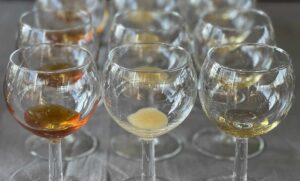
Av Ragna R Jørgensen, honningsensoriker, prosjektleder for ByBi Honning
I gjennomføring av en sensorisk vurdering skiller vi mellom aroma og smak (flavour). Både fordi nese og munn består av ulike sansereseptorer, og fordi flere honninger gir svært ulik aroma og smak. Installer deg til så du er så uforstyrret som mulig. Rommet må være luktfritt. Lukk øynene, synet er en sterk sans som forstyrrer fokuset lett. Smaksskje av metall (ikke sølv) anbefales. Velg to-tre honninger samtidig så du kan sammenligne.
Dekk gjerne honningglasset til slik at fargen skjules, lukk øynene, trekk duften langsomt inn. Førsteinntrykket er særlig viktig. For luktesansen, som eneste sans, har direkte kontakt med minnesenteret i hjernen, der følelser vekkes som sterkest. Førsteinntrykket er en duftmarkør som hjelper deg til å gjenkjenne aktuell honning og lignende aromaer senere. Dette er personlig. Det kan være alle typer minner, slikt som vedstabelen til bestefar fra barndommens sommerferier.
Aromaemnene bygger opp sansebildet i ulike aromakomplekser , for eksempel: sødme, fruktig/syrlig, floral, treaktig, krydret, animalsk. Det er utviklet ulike aromahjul hvor disse begrepene brukes, Aromahjul. Se på hjulet som inspirasjon, ikke som fasit, for betydningen vil variere fra person til person.
Merk av din fargevurdering på Honning fargeguide.
